NYC’s Forgotten ‘War on Christmas Trees’
Discover how an obscure holiday crackdown affects festive street vendors today!


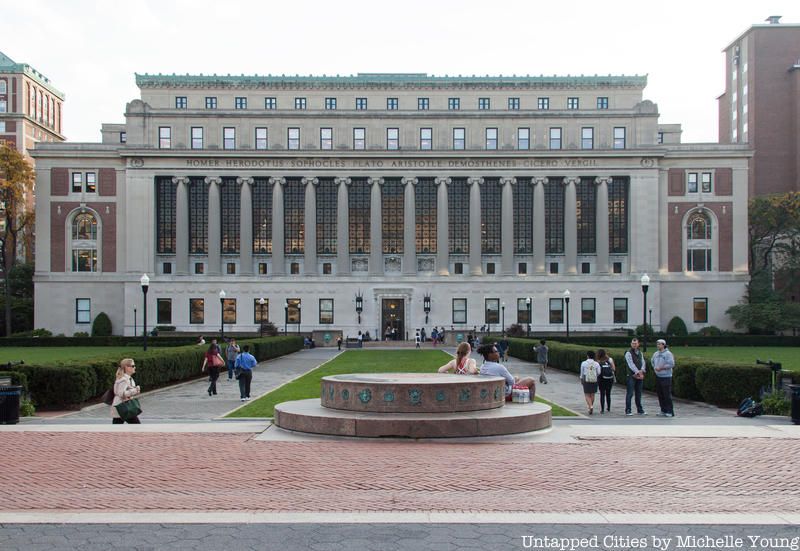
The Butler Library at Columbia University, which is one of New York City’s oldest operating schools.
When you think of New York City’s rich cultural history, educational institutions may not be among the first words that come to mind. But many of New York City schools have roots from hundreds of years ago and were an important part of the city’s development. In fact, quite a few of these New York City schools were important milestones in the nation’s educational history, with some even earning superlative spots among America’s finest institutions.
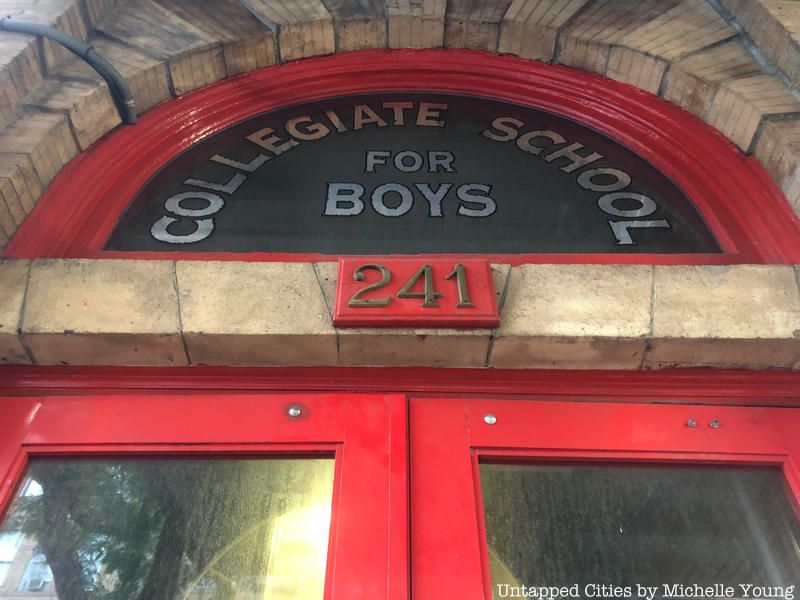
The Collegiate School on the Upper West Side is the oldest independent school in the United States. Established in 1628 by the Dutch West India Company and the Classis of Amsterdam, which was the regional assembly for the Dutch Reformed Church boards, the school remains an all-male K-12 institution. Impressively, the school has only closed once in its four-hundred year history: during the American Revolution, when many people had to leave the area that is now New York City.
The Collegiate School was originally located just south of Canal Street, but this changed as New Amsterdam grew northward. Finally, in 1892, the school moved to its current location on West 78th Street. The Collegiate School became a non-profit institution in 1940. Though it is no longer directly run by a church and accepts males of all faiths, it still maintains its relationship with the Collegiate Churches and shares facilities with the West End Collegiate Church.
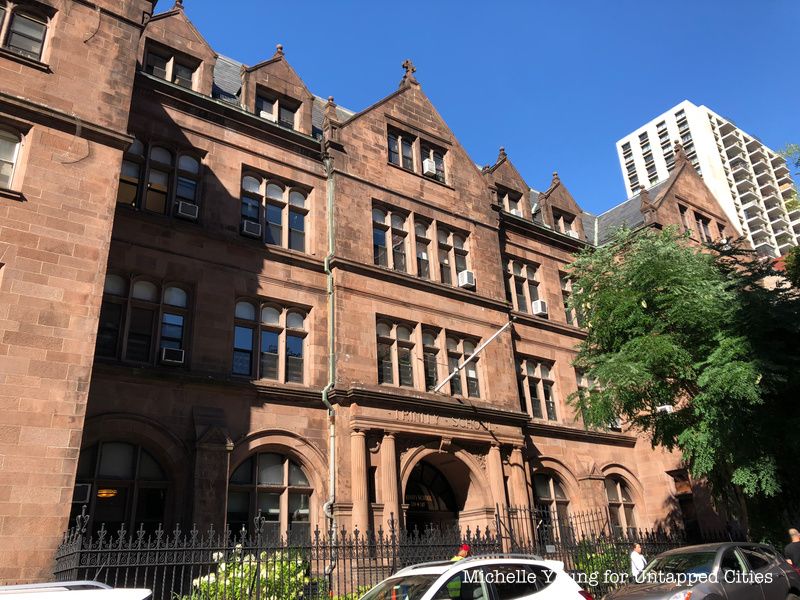
The Trinity School, which is also a private K-12 institution on the Upper West Side, is the fifth oldest school in the United States and welcomes both genders. Founded in 1709 as a school for charity supported by Anglican missionaries in 1709, classes initially took place at Trinity Church. In 1749, it had its first schoolhouse on the church grounds, making it the oldest “continuously operating educational institution in the city of New York.”
Founded by William Huddleston and available to both girls and boys at its founding, the school developed close ties to Columbia University (up next on this list) during its early years. By 1789, the school had 30 girls and 56 boys and no longer ran as a charity school. But in 1838, girls were prohibited and could no longer attend Trinity until 1971. In addition, it no longer receives endowments from Trinity Church, since it cut ties with the church in 1968.
While the school has continuously operated, it has changed locations quite a few times; in 1889 it moved to Madison Avenue and the next year moved to West 45th street.
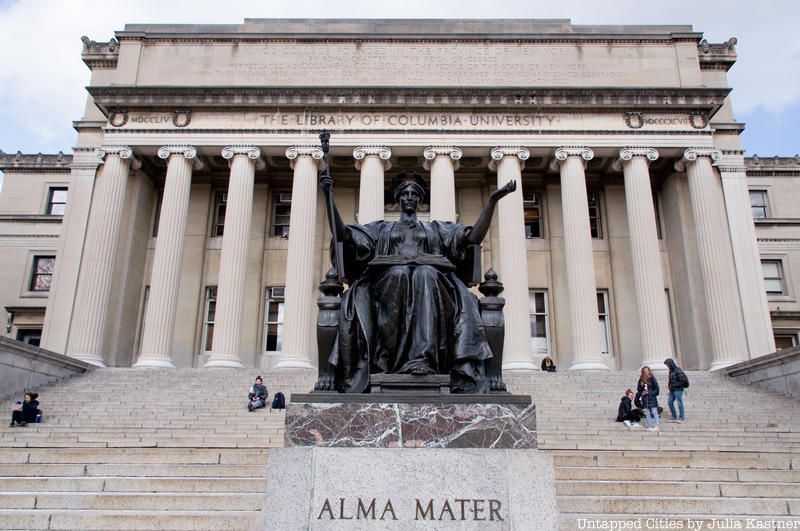
Now an Ivy League school, Columbia University has an equally complex, ambitious history. Established in 1754 as King’s College through a royal charter from England’s King George II, it is now the oldest higher education institution in New York (and the fifth oldest in the United States). City officials and Anglicans argued over the school’s location and religious affiliation, which is to be the Church of England.
Samuel Johnson taught the first classes to just eight students on the first floor of a Trinity Church schoolhouse. Despite this small start, in 1767, Columbia became the first American medical school to offer the M.D. degree. This flourishing ceased with the American Revolution, when instruction stopped from 1776 to 1784.
Afterwards, the college looked to the State of New York for assistance in restoration, and the state consequently started a Board of Regents to direct the college. However, its reputed students and trustees – John Jay, Alexander Hamilton, and Robert Livingston – ensured its continued prominence, and it reopened as a more diverse institution in 1784 with the official name “Columbia College.”
From 1857 to the end of the century, the college moved to 49th street and Madison Avenue; here, the college underwent the bulk of its development. The Columbia School of Law was established in 1858, the all-women’s Barnard College became affiliated in 1889, and graduate-level amenities were created.
In 1897, under President Seth Low, it relocated to its current location in Morningside Heights on the location of the former Bloomingdale Asylum.
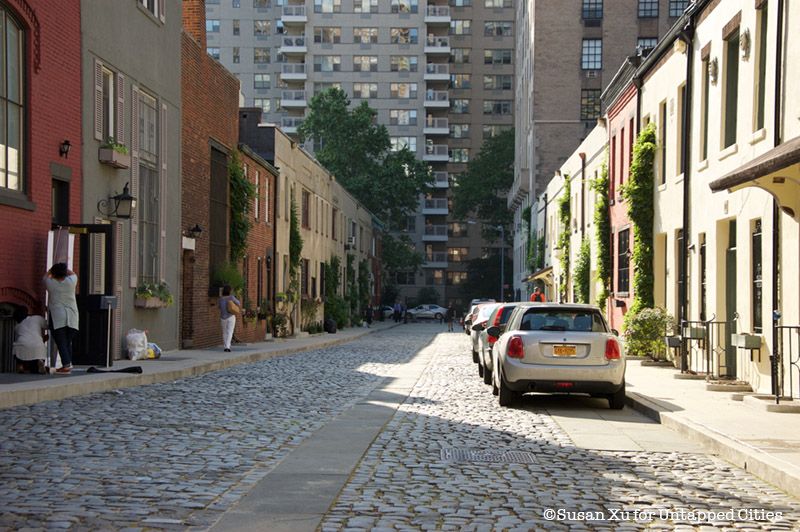
Members of the wealthy class of merchants, bankers and traders, who had the vision of creating a school where young men could gain admission based on merit rather than class, established New York University in 1831. At a City Hall Convention in 1830, over 100 delegates discussed the potential of establishing a school based on the University of London.
When the state and city rejected NYU trustees for funding, they raised $100,000 themselves. The founders also abandoned the classical curriculum for their school, which was funded by stock sales to stop religious denominations from directing the school.
While NYU signs and buildings are spread across several areas of the city, its first classes were held at Clinton Hall at the intersection of Nassau and Beekman Street, its sole facility for the first few years. Three years after its opening, the University Building in Washington Square East opened. Since then, it has rapidly expanded, often controversially.
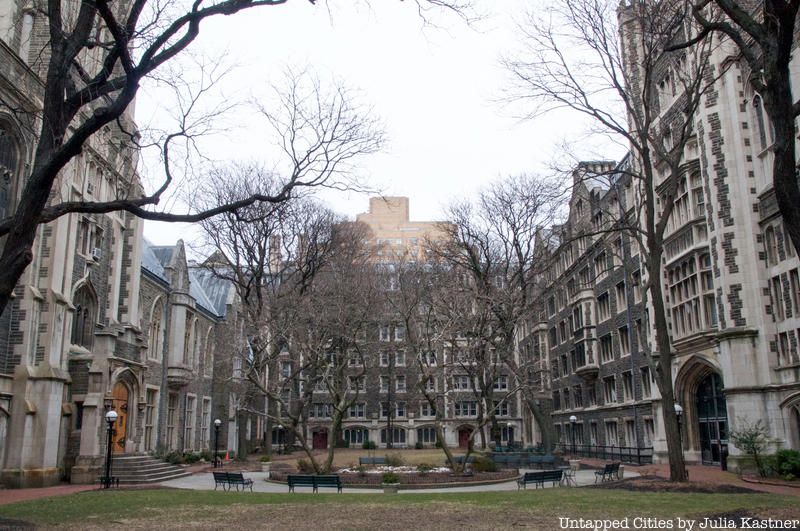
The oldest independent seminary in the United States, the Union Theological Seminary, located at 121st Street and Broadway, and affiliated with Columbia University, was founded in 1836 by members of the Presbyterian Church. However, students of all religions could attend.
During the late 1800s, the seminary became the American hub of liberal Christianity and became independent of the Presbyterian Church in 1893. Its members played a large part in the settlement house movement by establishing the Union Settlement Association in East Harlem.
In the 1960s, the decline of liberalism led to financial strains with a smaller student base. When the school consented to lease some of its land to Columbia, it became more fiscally stable.

Fordham University founded in 1841 by the Irish immigrant and Bishop of the Diocese of New York, John Jay Hughes and originally known as St. John’s College. Fordham was the first Catholic institution of higher education in the northeastern U.S. With dreams of building a seminary, Hughes purchased 100 acres of land at Rose Hill in the Bronx – it wasn’t until the 1960s that Fordham’s second Lincoln Center campus developed.
However, Hughes desperately needed money to fund it. Thus, in addition to raising $10,000 locally, he went fundraising for money in Europe, showing the poor status of many Catholics in America at the time.
Hughes then employed exiled Jesuits, who arrived in the 1840s, as teachers, and the school has expanded its programs since then. Its name became “Fordham” in 1907, two years after the establishment of its law and medical schools.
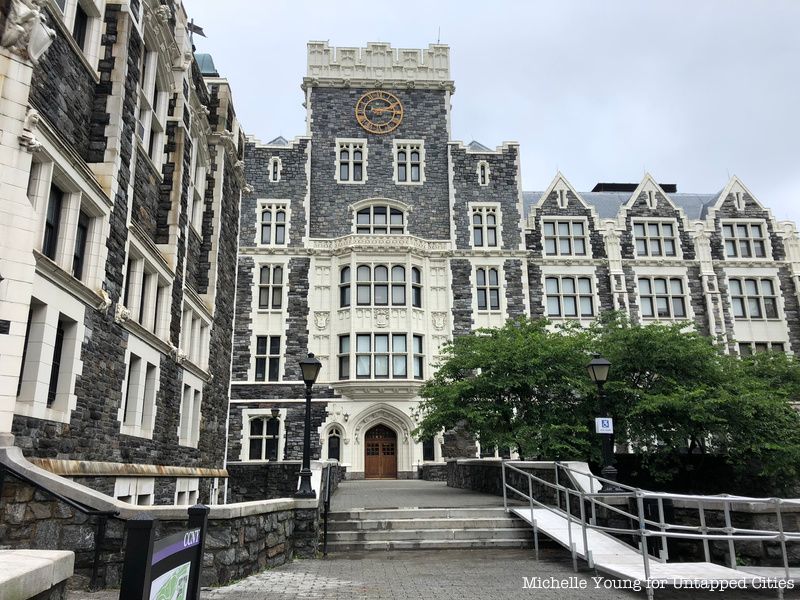
Its vast green lawns and Gothic-style buildings have earned the City College of New York (CCNY) the title “Hogwarts of Manhattan” by Harry Potter affecionados. The man behind this neo-Gothic architecture was George Browne Post, who designed it when CCNY moved to its current location in 1906. The buildings were built out of Manhattan schist excavated from the construction of the New York City subway.
But originally, the diplomat and businessman Townsend Harris founded CCNY downtown in 1847 as the “Free Academy of the City of New York.” He aimed to provide free education to the poor and descendants of immigrants. This institution became the first college in the CUNY system, with Hunter College and Brooklyn College, which were established in 1870 and 1930, respectively, following suit.
Dr. Horace Webster was the first president of CCNY, and from the start, the curriculum included nine subjects. Unlike many contemporary private schools, including the nearby Columbia College, CCNY saw male students of several races and social classes graduate (this would eventually include women in 1930). The first class graduated in 1853.
The “Free Academy” became “The College of the City of New York” in 1866, and then in 1961 became “City College of the City University of New York” when the CUNY system developed.
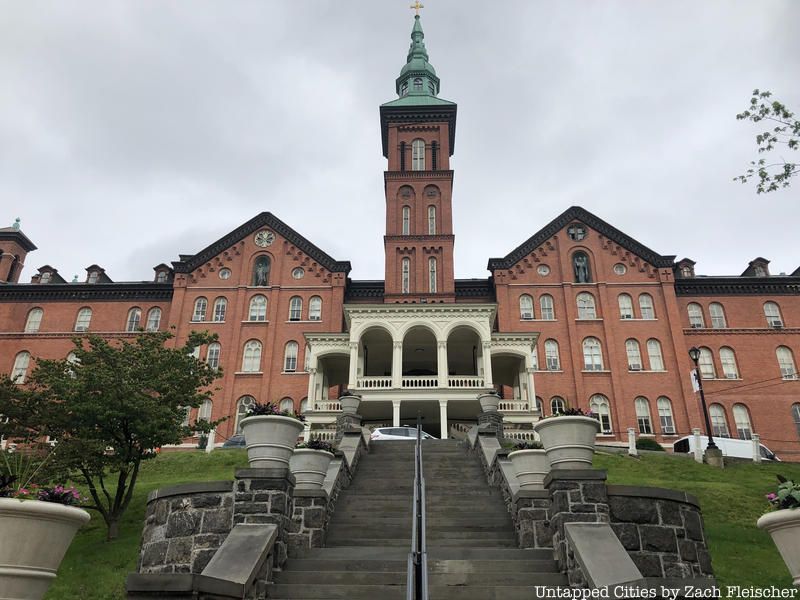
Though not as well-known, the College of Mount Saint Vincent has been standing for a while. The school’s story begins in 1817, when Saint Elizabeth Ann Seton sent a group from the Sisters of Charity to New York City to help run an orphanage on Mott Street. Recognizing the importance of education in improving the neighborhood, they started schools and founded New York’s parochial education system.
According to the college’s website, in 1847, the sisters founded the Academy of Mount Saint Vincent-the first institution in New York to offer higher education to women. In 1859, it moved to Riverdale in the Bronx, and in 1911 it officially became a collegiate institution.
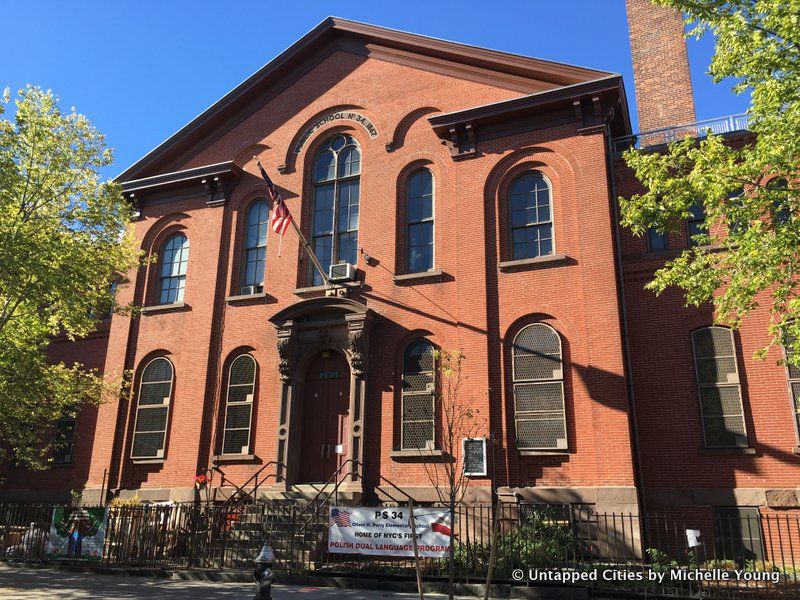
The red brick facade of P.S. 234, New York City’s oldest public elementary school.
Many may not know that Greenpoint, Brooklyn is home to the oldest public elementary school in New York City: P.S. 34. Designed by Samuel B. Leonard and built in 1867, the imposing, red brick building is hard to miss, and the P.S. 34 administration take pride in overseeing “the oldest continuously operating elementary school in Brooklyn.”
The building itself was used as a hospital during the Civil War, so that the former wards became the current classrooms. The Romanesque Revival building is a New York City Landmark today, and its establishment was part of the nineteenth-century drive for public education in Brooklyn, which shaped the neighborhood significantly.

One large, Neo-Gothic building stands out in Flushing: Flushing High School.The original building was three stories and on the corner of Union Street and Sanford Avenue. It had a first graduating class of six students. However, by 1891, as people flooded into Flushing and the student body grew, officials decided to add more rooms. Eventually the school population grew so much that they agreed to provide a new building at its current location on Northern Boulevard and Union Street, which was constructed on September 8, 1915.

Though it no longer functions as its original institution, Erasmus Hall Academy, the building still stands in Flatbush, Brooklyn. It was named for Desiderius Erasmus, who was a Dutch Renaissance Humanist and was also the first secondary school chartered by the New York State Regents, and was turned over to the public school system in 1896. It expanded at the start of the 1900s as Brooklyn’s population grew, and it is now a designated New York City landmark and a museum displaying the school’s vibrant history. When Erasmus Hall High School started doing poorly, the city closed it in 1994. Today, it stands as Erasmus Hall Educational Campus and is home to five separate small schools.
For more about the history of New York City colleges, read about The Top 15 Secrets of Columbia University in NYC, NYC’s Forgotten Rutgers Female College, and The Past Life of CUNY’s Hunter College. Get in touch with the author @sgeier97
Subscribe to our newsletter